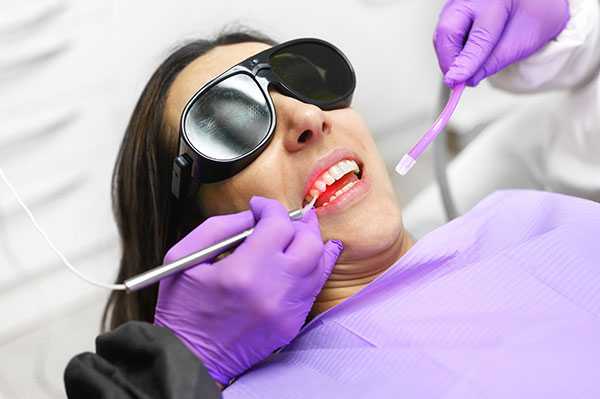Antibiotic Therapy for Gum Disease in Knoxville, TN
Your Knoxville Dentist’s Powerful Weapon Against Periodontal Disease
Periodontal disease affects millions of Americans, but finding the right dentist near you in Knoxville, TN, can make all the difference in your treatment outcome. At our dental office, we utilize advanced antibiotic therapy techniques to help patients achieve optimal dental health and maintain their healthy smile for years to come.
If you’re searching for effective gum disease treatment or need a trusted dentist in Knoxville, TN, our experienced team provides personalized dental care that addresses bacterial infections at their source. Contact our Knoxville dental office today at (865) 687-8670 to schedule your appointment and discover why patients throughout the Knoxville area trust us with their oral health.
What Is Antibiotic Therapy for Gum Disease?
Antibiotic therapy represents a targeted treatment approach that specifically addresses the bacterial infections causing periodontal disease. When harmful bacteria accumulate below the gum line, they create an environment that leads to inflammation, swelling, and potential tooth loss if left untreated.
Our Knoxville dentist combines antibiotic therapy with traditional dental treatment methods like scaling and root planing to maximize treatment effectiveness. This comprehensive approach helps kill bacteria, reduce inflammation, and restore good oral health while preventing the infection from spreading to other areas of your mouth or body.
The most effective antibiotic treatments work by targeting specific microorganisms responsible for gum disease, allowing your immune system to heal damaged connective tissue and supporting structures around your teeth.
Why Choose Our Knoxville Dental Office for Antibiotic Therapy?
As your trusted dentist in Knoxville, TN, we combine advanced techniques with personalized care to deliver exceptional results. Our dental team stays current with the latest developments in antibiotic therapy and periodontal treatment to ensure you receive the most effective care available.
We understand that every patient’s needs are unique, which is why we take a personalized approach to treatment planning. From your initial consultation through follow-up care, we’re committed to helping you achieve and maintain optimal dental health.
Our state-of-the-art dental office serves patients throughout Knoxville and surrounding communities, including Amherst, Marble City, and West Knoxville. We pride ourselves on creating a comfortable, welcoming environment where patients feel confident in their dental care decisions.
Types of Antibiotics Used
Our dental team prescribes various antibiotics based on your specific needs, medical history, and the severity of your periodontal disease:
Oral Antibiotics
- Amoxicillin: Effective against many bacterial infections, this beta-lactam antibiotic is commonly prescribed for moderate to severe gum disease
- Doxycycline: Part of the tetracycline family, particularly effective at reducing inflammation and stopping bacterial growth
- Azithromycin: A macrolide antibiotic that prevents bacteria from producing essential proteins needed for survival
- Ciprofloxacin: Used for specific bacterial infections that don’t respond to other antibiotics
Topical Antibiotics
- Minocycline (Arestin®): Applied directly into periodontal pockets during dental procedures
- Chlorhexidine: An antimicrobial agent used as a mouth rinse to reduce bacterial load
Prophylactic Antibiotics
For patients with certain medical conditions or those undergoing dental implants or other invasive dental procedures, prophylactic antibiotics may be prescribed to prevent infections before they occur.
Benefits of Antibiotic Therapy at Our Knoxville Dental Practice
Choosing antibiotic therapy for gum disease treatment offers numerous advantages:
- Immediate Relief: Most patients experience symptom improvement within days of starting treatment, with reduced swelling and discomfort.
- Infection Control: Antibiotics effectively kill bacteria and prevent the spread of infection to surrounding tissues, the jawbone, or the bloodstream.
- Enhanced Treatment Outcomes: When combined with scaling and root planing, antibiotics significantly improve the success rate of non-surgical periodontal treatment.
- Convenient Administration: Available in multiple forms, including pills, mouth rinses, and topical applications, to suit different patient needs and preferences.
- Minimal Side Effects: Most patients tolerate antibiotic therapy well, with few adverse reactions when properly prescribed and monitored.
- Prevents Complications: Early intervention with antibiotics can prevent the need for more extensive dental procedures like root canals or tooth extractions.
How Antibiotic Treatment Works in Treating Gum Disease
When you visit our dental office near you in Knoxville, our dentist will evaluate your specific condition to determine if antibiotic therapy is the right treatment option. The process typically involves:
- Comprehensive Examination: We assess the extent of your periodontal disease and review your medical history for any drug interactions or adverse reactions
- Bacterial Testing: In some cases, we may test to identify specific bacteria causing your infection
- Customized Treatment Plan: Based on our findings, we create a personalized approach combining antibiotics with other dental treatments
- Medication Prescription: We prescribe the most appropriate antibiotic based on your specific needs and medical history
- Ongoing Monitoring: Regular follow-up appointments ensure treatment effectiveness and address any concerns
The antibiotics work by entering your bloodstream and concentrating at the infection site, where they either kill bacteria or inhibit their growth. This allows your immune system to heal damaged tissues and restore healthy gum function.
Antibiotic Alternatives and Complementary Treatment Options
While antibiotics are highly effective, our Knoxville dental team also offers complementary treatments that can enhance your results:
- Laser Therapy: Advanced laser techniques remove bacteria and infected tissue while promoting the healing of healthy tissue.
- Scaling and Root Planing: This deep cleaning procedure removes plaque and tartar from below the gum line, creating a clean environment for healing.
- Probiotics: Beneficial bacteria that help restore balance to your oral microbiome and support long-term dental health.
- Antimicrobial Mouth Rinses: Specialized rinses that continue fighting bacteria between dental visits.
Costs of Antibiotics and Dental Insurance Coverage
The cost of antibiotic therapy varies based on many factors, including the specific medications prescribed, treatment duration, and your dental insurance coverage. Our office works with most dental insurance plans and provides transparent pricing for all dental services.
Generic antibiotics are typically more affordable than brand-name medications, and our team will always discuss cost-effective treatment options that don’t compromise quality of care. We believe that good oral health shouldn’t be limited by financial concerns, which is why we offer flexible payment options for patients throughout the Knoxville area.
Frequently Asked Questions
Most patients notice improvement in their symptoms within three to five days of starting antibiotic therapy. However, it’s crucial to complete the full course of treatment as prescribed, even if symptoms improve quickly. This ensures complete elimination of the bacterial infection and reduces the risk of antibiotic resistance.
Common side effects may include mild stomach upset, diarrhea, or yeast infections. Some patients may experience allergic reactions such as rash or difficulty breathing. Our Knoxville dentist will review your medical history to minimize the risk of adverse reactions and provide guidance on managing any side effects.
While antibiotics are highly effective at killing bacteria and controlling infection, they work best when combined with other dental treatments like scaling and root planing. This comprehensive approach addresses both the bacterial infection and the underlying factors contributing to periodontal disease, such as plaque buildup and poor oral hygiene.
Follow-up appointments are typically scheduled one to two weeks after starting antibiotic therapy to monitor progress and address any concerns. The frequency of visits depends on the severity of your condition and your response to treatment.
Most dental insurance plans provide coverage for medically necessary antibiotic therapy as part of periodontal treatment. Our office staff will verify your coverage and help you understand your benefits before starting treatment.
Take Control of Your Oral Health With Antibiotic Therapy for Gum Disease
Don’t let gum disease compromise your dental health and overall well-being. Antibiotic therapy offers a proven, effective solution for treating bacterial infections and preventing serious complications. With proper treatment and ongoing care from your Knoxville dentist, you can enjoy a healthy smile for years to come.
Ready to get started? Our experienced dental team is here to help patients throughout the Knoxville area achieve optimal dental health through advanced antibiotic therapy and comprehensive dental care. Contact our dental office today to schedule your comprehensive examination and learn more about how antibiotic therapy can help restore your oral health. Call (865) 687-8670 to book your appointment with the most trusted dentist near you in Knoxville, TN!

